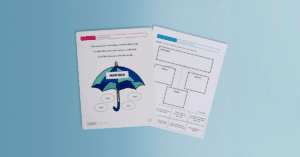You just finished evaluating a student who stutters. You delivered a stellar report, and the student qualified for services. Now what do you do? Do you just dive into fluency strategies? Will that do the trick?
If you’re wondering where to start, you’re not alone!
Before Teaching Fluency Strategies
There are several reasons why we need to address more than fluency strategies.
One fluency strategy may increase a student’s fluency by 20% percent in the speech room. However… What does that look like in the classroom? Will the increase in fluency persist over several sessions? Into next year?
I love the proverb “give a man a fish and you feed him for a day; teach a man to fish and you feed him for a lifetime.” This applies to so much of what we do in therapy, but it especially applies to our students who stutter.
We know that “school-age children will, in all likelihood, continue to stutter in some fashion throughout their lives” (Yaruss, 2018). They are going to need more than a strategy or two to understand their stuttering and navigate their way through moments of disfluency.
By teaching our students about stuttering and helping them understand how the speech system works, we’ll be teaching students to “fish” (i.e., understand their stuttering). We’re empowering them and giving them the tools to speak fluently.
Here are some strategies (and free resources!) that I use to accomplish these goals in stuttering treatment:
Step 1. Normalize Stuttering
I love doing a mini-unit on famous people who stutter. (Stuttering Help has a super helpful resource.)
We also take time to discuss the fact that we all have moments of disfluency from time to time, and that’s okay. We emphasize and drive home that it’s okay to stutter.
Step 2. Introduce the Speech Machine
This is foundational when it comes to teaching any fluency strategies. If students understand how the “system” works, they’ll have the tools they need to “change the system” and speak more fluently. Lacey from Speech Me Maybe has a free interactive activity that makes it easy to introduce the speech mechanism to students.
View this post on Instagram
Step 3. Talk About Stuttering
Once students understand the speech mechanism, we can talk about what happens when we stutter. We can move through the different parts of the speech mechanism and talk about what would happen if the different components are tight versus loose.* For example, if I try to say “ball” with tension in my lips, it might come out as “b-b-b-ball.” I often model what the tightness looks like and have students try it themselves.
* We might have to teach the difference between tight versus loose! I start with larger body movements (e.g., making a tight fist) to show the difference.
Step 4. Become a Speech Detective
We then get to become speech detectives!
I model different types of stuttering, and we identify what happened in the speech mechanism to make that happen. For example, if I say “passsssssport,” we can guess that I had tension in my tongue.
Students can then take turns imitating me and/or creating their own disfluencies to “experiment” with the speech mechanism. We might also find videos of students who stutter (like this one) and “analyze” their moments of disfluency.
Step 5. Increase Awareness of Stuttering
The student can then start to identify stuttering in his/her conversational speech and “analyze” the disfluency using what we learned about the speech mechanism.
After going through these steps, students are armed with knowledge that they can use to understand their stuttering. This is key when it comes to implementing strategies.
If you want to learn more about this stage of therapy, check out Nina Reeves and Dr. Scott Yarus’s book, School-Age Stuttering Therapy: A Practical Guide.
If you can’t wait to learn more about fluency strategies, then join us again next week!
Hope to see you next week as we dive into fluency strategies!




Hey Marisha!
Do you happen to know of any resources or research that addresses stuttering therapy for individuals with intellectual disabilities? I’m excited to check out the free resource from Speech Me Maybe – thanks for sharing it!
I haven’t done a lot of research in that area, but here is one article that came up (https://www.sciencedirect.com/science/article/pii/S1877042815020649). Are you wondering about anything in particular?
Hey Marisha, do you have any therapy ideas for 3 year old who starter stuttering a month ago when her little brother was born? Thann you
I’d recommend reaching out to Stephen Groner! You can find him on Instagram or at slpstephen.com.